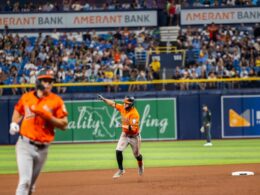Kamala Harris’ emergence as the Democrats’ presidential nominee seems to have upset the pre-Harris narrative that the race would be decided by the “double haters” — voters who disliked Donald Trump and Joe Biden.
Not so fast.
That group is smaller than it was but still holds the key to the outcome.
Before Biden’s decision to drop out, the number of double haters was the highest in modern American history. The precise total varied depending on the poll, but generally between 20% and 25% of voters disliked both men.
That was substantially higher than the prior record, the 18% who disliked both Trump and Hillary Clinton in the 2016 contest. These voters decided that race by backing Trump with a 17-point margin. That allowed him to close a 5-point gap in favorability, letting him get close enough to Clinton in the popular vote to allow him to capture an Electoral College majority.
Common wisdom so far is the double haters are no longer so crucial. It’s true they have shrunk dramatically in size, but the near-parity between Trump’s and Harris’ favorability numbers means they still hold the key to the election.
I calculated the two candidates’ favorability ratings using polls taken at least partially on or after June 21, when Biden announced his departure. Harris’ popularity has surged, but she still has only a 44.7% favorability rating. Trump’s is statistically identical at 44.3%.
Do the math: Assuming no one likes both candidates, 11% of voters still are not favorable to both people. That’s much lower than pre-June 21 or 2016, but it is much higher than 2020’s 2%.
This puts them in the campaign’s driver’s seat. Exit polls show voters who like a candidate are almost certain to vote for them. Clinton got 98% of the people who liked only her in 2016, for example, and Biden got 95% of those who liked him in 2020.
Trump’s numbers in both races mirrored the two Democrats’: If you liked him, you were 95% to 98% likely to vote for him.
Based on this, the national race is essentially tied right now. That means the double haters have as much power as they did in 2016 to determine the victor even though their numbers have shrunk.
We don’t have any hard analysis of these voters; it’s too soon for that given Harris’ quick polling rise. But the inferential data suggest they would tilt slightly toward Trump if forced.
This is what a careful look at the difference between what the two-candidate polling shows and what polls that include Robert F. Kennedy Jr. and other minor-party candidates conclude.
Trump leads the two-candidate race by 1.2 points on the RealClearPolitics polling average. But he leads the multi-candidate race on the polling average by only 0.3 points.
The inference is clear. We know that nearly 100% of third-party-candidate votes come from “double haters.” The fact that Trump gains once third-party candidates are removed from polls shows he would be their favorite right now if they were forced to choose between him and Harris.
This matters because of the known propensity of double haters to drop their support for third-party candidates at the last minute. That happened in 2016, where the final pre-election polling average showed Libertarian Gary Johnson and Green Jill Stein winning a combined 6.6%, with Trump trailing by 3.3 points.
But when the votes were tallied, Johnson and Stein won only 4.4% between them. Trump lost by only 2.1%. That last-minute shift gave him the votes he needed to narrowly win the presidency.
It may be that one candidate will surge in popularity and make the analysis moot. If Harris or Trump, for example, has a 50% favorability on Election Day, she or he will garner about 50% of the vote and probably win.
But if neither candidate gets to that magic mark, all bets are off. If the two candidates’ favorability remains well below 50% and within a point or two of one another, it doesn’t matter how small the double-hater category is. They will decide the winner if they break even a bit in favor of one candidate.
It rarely pays to bet against the house, but political common wisdom isn’t the house. Watch the two candidates’ favorability ratings closely as the race heats up. If it stays as close as it is now, figuring out where the double haters will go will be the difference between victory and defeat.







